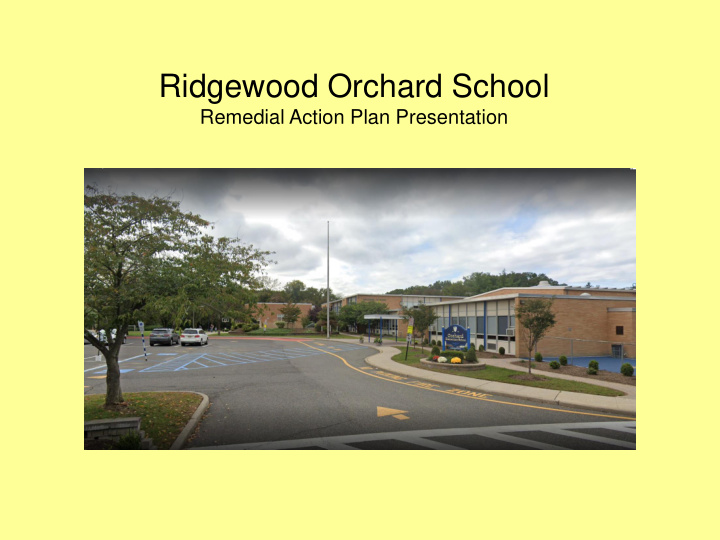



Ridgewood Orchard School Remedial Action Plan Presentation
Agenda • Opening • Historical Chronology • Nature of the Historic Fill at the Site • Purpose of the Remediation • Remedial Action Plan • School Physician • Q&A
Site Chronology 1910 – 1950 Residential coal ash from Village was disposed in the area (“Ridgewood Ash Landfill”) 1950 – 1960s Ash fill was covered with local soil materials (“Historic Fill”) Orchard School constructed on former Ash Landfill 1980’s Investigation by PSEG of former Ridgewood Gas property Ash fill found throughout neighboring properties including Orchard School 1990’s Discussions between Ridgewood Village, PSEG and NJDEP regarding how ash fill should be addressed NJDEP recommends ensuring the burial of any visible ash material by at least 18 inches of soil across the property, where not already extant 1997 Remedial Action Workplan (RAW) submitted to NJDEP on behalf of Ridgewood Board of Education to complete the work at Orchard as recommended 1998 Remedial Action Workplan (RAW) was approved by NJDEP 2000 Regrading work at site was completed 2001 Remedial Action Report filed with NJDEP along with draft Deed Notice for approval
2001 – 2007 No review or approval of report or Deed Notice by NJDEP; project ended in 2001 2007 Ridgewood decides to conduct sampling for pesticides/herbicides in soil at Orchard School. PAHs and metals added to analysis PAHs detected above cleanup criteria Meeting with NJDEP at Orchard School to discuss next steps Board temporarily closes field pending additional evaluation Public meeting to present results Sampling workplan submitted to NJDEP for review and comment Additional sampling found that historic fill material extends across entire property and contain PAHs above criteria Report summarizing results submitted to NJDEP NJDEP declined to make any recommendation or to attend public Board meeting At public Board meeting, Board decided to reopen field based on opinion of its experts that results present minimal risk
2008 NJDEP publishes enforceable PAH remediation standards 2009 Site Remediation Reform Act was passed establishing a required timeline for all sites to be remediated and to retain an LSRP by 2012 2012 Board retained LBG to provide LSRP services 2014 Remedial Action/Remedial Investigation Report was filed with NJDEP summarizing the 2001 regrading and the 2007 sampling results 2017 NJDEP revised PAH remediation standards Decision to request alternate cleanup standard for the site based on recreational use scenario. Preparation of draft Risk Assessment 2019 Risk Assessment document was submitted to NJDEP NJDEP determined that alternate standard would not be approvable at a school property per policy; only acceptable approach would be removal or cap-in-place Conceptual remedial plan discussed with NJDEP to cap material on-site, with consideration of site land use constraints NJDEP conceptual approval of a cap that would allow use of cover material in floodplain
2020 Submission of Land Use Permit Submission of RAW Out to bid Perform Cap-in-Place Remediation Prepare Final Remedial Action Report Soil Remediation Permit with Deed Notice Prepare Response Action Outcome (RAO) 2021 Remedial Action deadline Begin Long-Term Monitoring and Certification
1959 Air Photograph Shortly Before Orchard School Construction
The cap at the site is primarily existing onsite soil (assumed to be clean). Some areas were regraded to ensure that the ash material was at least 18 inches below grade. Six inches of imported clean soil was added to the areas indicated to achieve required burial depth. 2000 – Areas Requiring Fill and Grading to Achieve Minimum 18-inch Depth to Ash
2000 – Playground Area Requiring Mulch Fill
Historic Fill
2007 Soil Sampling Program
Nearby areas with known Historic Fill
PAHs Metals Benzo(a)pyrene (BaP) is the most common constituent exceeding residential standards in historic fill The NJDEP database shows BaP concentrations in New Jersey Historic Fill range from 0.02 to 120 ppm, with an average concentration of 1.89 ppm NJDEP - Chemical Constituents in New Jersey Historic Fill
AREA BaP Area 1 2.37 Area 2 1.77 Area 3 2.50 Area 4 1.74 Area 5 1.06 Average 1.93 Shallow NJDEP 0.50 Residential NJDEP 2.00 Non-Residential 2 samples (4%) exceeded lead standard 1 sample (2%) exceeded arsenic standard 2007 – Average benzo(a)pyrene as measured in shallow Historic Fill (ppm)
Remediation Plan • Purpose of the remediation is to comply with NJDEP policy that requires meeting the 0.5 ppm residential standard for benzo(a)pyrene (and other PAHs) • The standard can be achieved through capping the historic fill with clean soil and other barriers • The work can be completed within the statutory timeframe established for this site under the Site Remediation Reform Act
Recommend
More recommend